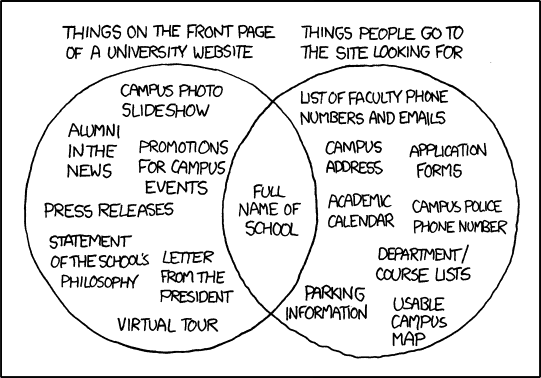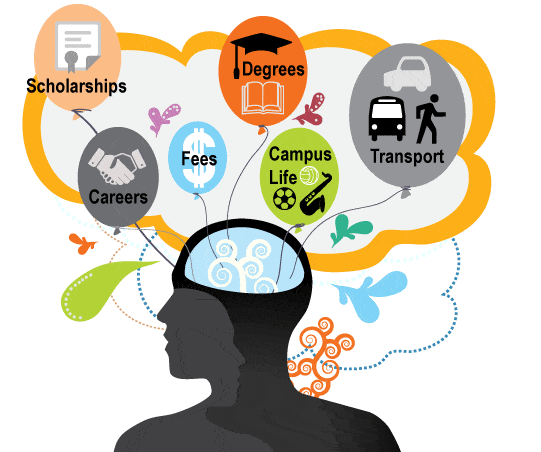Part 1 - Understanding user needs
In the last few years, we have seen a shift towards our university clients starting to focus on understanding their users and their needs. Many universities have learnt from the mistakes of their past where they were pushing their own agendas with little understanding of current or future student needs e.g. big campaign sites.
This being said, there's still a lot of room for improvement. Research published by the Nielsen Norman Group in January 2014 noted that "users are often frustrated or thwarted by the frequent usability problems on university websites" (from University Websites: Top 10 Design Guidelines).
Over the last 6 years, members of the Peak Usability team have worked on over 15 projects for 12 universities, higher education institutions or university admission organisations in Australia and the United States, with prospective and current students from across the globe. 10 of these studies were conducted in the last 2 years. We examined current and future students' needs, and unearthed numerous issues that occurred when users' needs for information were not met. Part one of this article focuses on how future students evaluate a university's standing, as well as what information both prospective and current students generally look for in university websites.
How future students assess a university's reputation
We learned that future students use a university's website as one of the primary tools to assess a university's reputation.
- They focus on whether the site has credible information up front e.g. fees, course details, graduate success stories.
- They may look into the professional standing of lecturers.
- They want to see if a university has any prestigious industry linkages.
- The visual site design of the website plays a key role in assessing the reputation of the university i.e. a cutting edge modern looking website = a cutting edge modern university.
While prospective students assess a university's reputation directly through its website, we discovered that another important factor came into play - word of mouth. Word of mouth from friends and family (also known as key influencers), as well as written reviews (from external sources) has a powerful effect on a prospective student's perception of a university.
Our research also revealed that prospective students' perceptions of the university's reputation increased if they were aware that an individual course/degree had achieved recognition at the regional, national, or international level.
Content
The number one goal of university website teams should be to better understand what content to highlight when trying to meet the needs of future students. By increasing the visibility of this critical information, and making it easier to find, you will have a better chance of turning prospective students into current students.
Randall Munroe published an excellent Venn diagram that demonstrates the relationship between what's on the homepage of a university website and what information users actually look for on the site. Randall's diagram for what users want to see on a home page are consistent with overall content priorities from our research.

(Image credit: Randall Munroe via his XKCD website)
Prospective students' needs
We've compiled a handy list of information needs of all prospective students based on our research findings. This is consistent across all universities we have conducted research for.

- Fees - This is a very important one for prospective students and their parents. We found that a lack of transparency around fees can significantly erode trust in a university's reputation. We appreciate fees are difficult to display as there are many dependencies on electives and majors, however, prospective students expect an approximate range for a standard degree at minimum.
- Degree or course information - Items such as duration, prerequisites, commencement date, and study mode e.g. flexible, online, and number of contact hours on campus.
- Career outcomes, employment opportunities, and future (potential) income - Would the degree they signed up for provide them with a viable income stream upon graduation?
- Scholarships - Do they qualify for any scholarships based on their situation? (Note: This information is less important for Australian year 12 students and more important for mature aged prospective students currently working).
- Campus life - Information on social, clubs, sports and extracurricular activities in addition to course information presented with lots of imagery.
- Getting to campus - public transport information and parking etc.
…and another handy nugget – they don't like to read! Prospective students prefer a visual representation of information e.g. photos of campus life, short videos, use of icons or graphics rather than large paragraphs of wordy text.
Alternative entry and mature students
Alternative entry and mature students often look for additional information to suit their specific needs. In general, it is critical for them to find a university that provides them with flexibility - lots of flexibility. This group needs to know all of the course commencement dates - do they have the option to start their course in Semester 2 or 3, or is there only option to start in Semester 1? They also need all the mode of (course) delivery optionslisted e.g. full time/part time, online/external/on campus, as well as time on campus (contact hours).
Bonus information on research students… Prospective higher degree research applicants seek out information on potential supervisors/experts to supervise their topic of interest or seek expertise in research areas depending on how clear they are about their research topic. They are also very interested in scholarships and stipends.
Future international students
When we examined our data on international students, we found a unique subset of information they required in order to help them choose a university.
- Potential employment opportunities (in Australia if they choose to stay after graduation, or in their home country if they choose to return upon degree completion).
- Recognition of their degree in their home country e.g. CRICOS.
- Clarification of university terminology (including abbreviations and acronyms) and page readability(Note: More information on this topic will be available in Part 2 of this article).
- The level of safety in the city they will be living (Note: This is more important for parents and often increases after media report on incidents involving international students).
- Living and city information (including public transportation options).
- Cultural heritage clubs at the university.
Current students
We didn't want to leave out any research gems from our current student research over the past couple years, so here are our general findings consistent across a range of universities.
Top 5 current student information needs (overall):
- Current course information and resources
- Enrolment
- Class timetable (schedule)
- Course results
- Key contacts and staff directory
Top 5 current student information needs (mobile only):
- Current course information
- Exam, Assessment, and Results information
- Study/semester planner (scheduling)
- Key contacts and staff directory
- Maps and finding way around (campus)
Our researchers have state, national, and international university user experience research experience spanning 3 decades. We know universities and how they work and we want to share our knowledge with you, so get ready for a special, university-focused edition of our user experience training! Visit the training section of our website to find out how you can learn more about UX Design.
Stay tuned for Part 2 of this article, where we'll be focusing on common usability issues that occur on university websites. Sign up for our Newsletter to ensure you receive this article hot off the press!
Usability tip
Use task analysis to your advantage!
Task analysis (as defined by usability.gov) is the process of learning about ordinary users by observing them in action to understand in detail how they perform their tasks and achieve their intended goals.
It helps you understand: users' goals, what users actually do, users' personal, social, and cultural characteristics, users' context or environment, time for each task, information required, users' previous knowledge and experience, and issues with each task. It can also help align tasks with key functions, and avoid expensive redevelopments due to not understanding of how users perform tasks.